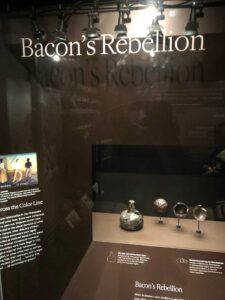Laura and I played hooky today and slipped up to Washington, D.C., on Amtrak to look at the cherry blossoms. It was gloomy and drizzly, so we opted instead for visiting the Museum of African American history. Laura breezed through the history portion of the museum and made it to the Oprah Winfrey exhibit. As is my habit — most annoying to other members of my family who visit any museum with me — I anally compulsively view and read each display.
I was pleased to note that the floor on slavery had a small booth in the “Chesapeake” slavery alcove dedicated to Bacon’s Rebellion. I was even more pleased to see that the commentary defied the current Leftist fashion of describing Nathaniel Bacon as racist for his conflict with Native Americans, and instead highlighted the multiracial nature of the rebellion he led. Reads the placard:
White landowners were terrified to see black and white workers united in any cause. In 1676 Nathaniel Bacon led a rebellion of black and white colonists against the governor of Virginia, William Berkeley. They demanded that Berkeley open up new lands for settlement, end Native American raids, and regulate the abuse of servants. The short-lived rebellion resulted in the government limiting European indentured servitude. The scales tipped. Europeans gained new rights and Africans lost their freedom.
African servitude in the English colonies began in 1619 when Dutch slavers sold the Africans into bondage at Jamestown. But England had no history or legal framework for slavery, so the status of Africans in early Virginia was amorphous. I’m not sure that Bacon’s Rebellion was quite the watershed it’s commonly portrayed as. Laws depriving Africans of the rights due white Englishmen were enacted before the Rebellion, and they were enacted after the Rebellion. The process converting black slaves into chattel was a process that took a half century, as the Museum history itself makes clear elsewhere.
Be that as it may be, I found the slavery section of the Museum to show much of the complexity and nuance of the “peculiar institution.” Not surprisingly for a museum focused on African-Americans, the exhibit told the story of slavery from the perspective of… African-Americans, not whites. The dominant theme was how Africans came to the English colonies and adapted to and resisted the horrors of slavery. They learned skills, they bargained, they negotiated, they literally purchased their freedom, they built their own traditions (especially through the church), they endeavored to hold their families together, they ran away — either to relative freedom in the North or to maroon colonies — they created alliances and trade networks with Native Americans, and they occasionally even rebelled.
I was struck by the contrast between how historians give tremendous agency to African-Americans in resisting slavery with how people of a certain ideological proclivity that shall remain nameless give 21st-century African-Americans very little agency, instead blaming all ills afflicting African-Americans today upon racism and institutional racism. At some point — it’s not exactly clear — African-Americans transmuted from heroes to victims.
One other point worth noting: The Museum seriously bashes Thomas Jefferson. There’s a handsome statue of Jefferson, but the museum commentary is eviscerating, contrasting his lofty words about equality in the Declaration of Independence with his history as a slave holder. No credit at all for articulating universal principles that would one day provide the ideological basis for freeing the slaves and providing equal rights to blacks.
To no one’s surprise, the narrative of the Museum is scrupulously politically correct. But it shows many facts of a complex institution, it emphasizes the humanity of slaves through personal stories, it reproduces amazing photographs and portraits that bring African-Americans of the era to life, and it provides an uplifting narrative of African-Americans asserting their autonomy and independence under horrific conditions. I can’t speak to the post-Civil War exhibits, which I didn’t see, but I would urge everyone to view the exhibits on slavery.


Leave a Reply
You must be logged in to post a comment.